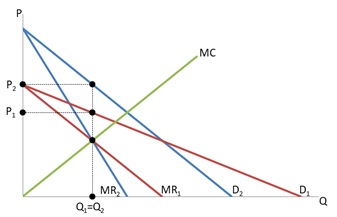Assignment:
These are all short answer questions. No specific format.
1. Demand vs. Marginal Revenue: A market with a single seller is referred to as a monopoly and the single seller would be referred to as a monopolist. Since a monopolist makes up the entire market, the monopolist can review the overall market demand and pick the price and quantity combination on the market demand curve that maximizes overall profits. If the market demand curve is negatively sloped (as we generally expect it to be) then if the monopolist wants to increase the quantity sold, this can only be achieved by accommodating the buyers by lowering the price (i.e., by moving down along the demand curve). Any firm facing a downward sloping demand curve is known as an imperfect competitor (or as an imperfectly competitive firm). Imperfectly competitive firms (such as monopolists, monopolistic competitors and oligopolists) all face downward sloping demand curves. This means that the marginal revenue (MR, the extra revenue from selling one more unit) is smaller than the price (P) of the last unit sold by the firm. The reason MR < P for a firm with a downward sloping demand is that the firm must cut its price on all the units it sells in order to sell an extra unit of output. Having a clear understanding of how this works is critical for understanding how imperfectly competitive firms operate.
Question 1: Carefully explain why we believe that a linear demand curve will always be associated with a marginal revenue curve that has twice the slope of the demand curve in question.
A true supply curve shows the relationship between price and quantity supplied. For the monopolist, the key issue to consider is that the monopolist does not make quantity decisions based on price, but rather based on marginal revenue.
This can be illustrated with the concept of price discrimination: The monopolist does not necessarily charge the same price for the same quantity in two separate markets for the same good, since the monopolist will first consider the elasticity of demand.
Consider the diagram below. Starting out with two different demand curves with corresponding marginal revenue curves (remember, MR has twice the slopes of the demand curve), just draw a marginal cost curve that crosses through the intersection of the two different marginal revenue curves. As you can see, since the two different MR curves represent different demand curves, the price will be different even when MC=MR gives the same quantity for each demand curve. In short, you do not have a one-for-one relationship between price and quantity, and this means that there is no stable supply curve here.

Question 2: In this context, in your own words carefully explain why economists say that a monopolistic firm does not have a true supply curve in the same sense that a perfectly competitive firm does.
Question 3: Give at least three examples of industries in which price discrimination is common. In each case make sure that you explain the nature of the price discrimination in question and why you believe it persists.